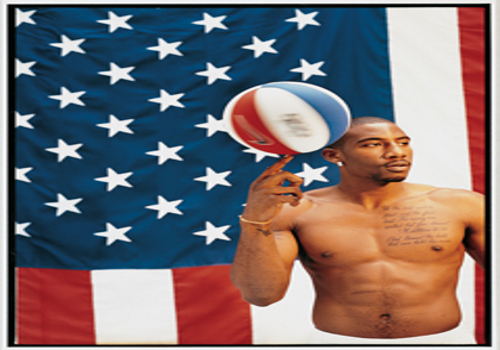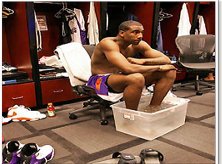
Corrective Exercise is a recent trend in fitness that doesn’t focus solely on “getting in shape” or “getting big.” The program is much more specific and can lead to great gains.
Because folks like Amar’e Stoudemire are pretty big dudes, it makes sense to bring up any training program he undertakes. However, since corrective exercise can work for anyone, we’ll also talk about the program as a whole.
Corrective Exercise is focused. Former Mr. Universe Dave Draper explains that it “broadly refers to specific exercise or stretches to target a defect in a person’s physical movement.” Corrective Exercise aims to “correct” the situation.
Some exercises are great for basketball players—especially those who are huge, like Amar’e—and those exercises may also benefit anyone who is looking to get big. Plus, your “pick up” game might improve as well!
You can take yourself through a corrective program or get “tested” by a professional trainer. The goal is to balance your body and put yourself on firm footing to have the symmetry you’ve been looking for.
As opposed to “pushing through” and “maximizing reps”, Corrective Exercise wants to balance your body. It is aimed at finding deficiencies in certain muscle groups and bringing them up to par.
Amar’e Undergoes a Test

Phoenix Suns Head Strength and Conditioning Coach Erik Phillips diagnosed Amar’e in a unique way. He had Amar’e do a squat with his arms overhead. Then he had Amar’e do a one-legged squat with his hands on his hips on each side.
The purpose of this test is to get multiple photographs from as many angles as possible. Comparison of these photographs will give you—or your trainer—an idea of how balanced your body is. Photographs of the body in motion will reveal deficiencies that the naked eye will never catch.
The corrective exercises prescribed are designed to balance “overworked” and “under-worked” muscles. If you do work that over-emphasizes your right side then your right arm will be stronger than your left. If you’re left-handed, then the opposite may be true. The test will tell the tale.
Even though the test is very short it tells you everything you need to know. Careful scrutiny of the photographs will constantly reveal new areas that you can work on–assuring that you’ll never get bored.
With Amar’e the test results were very specific.
Arm Overhead Squat:
Phillips observed that Amar’e’s feet turned out, his knees moved outward, and he leaned forward quite a bit. Those tendencies can be translated into a diagnoses and routine to correct the imbalance.
Because his feet and knees turned out, the deficiency was diagnosed as imbalanced abductors. When Amar’e was leaning forward, the deficiency was diagnosed as weak glutes/erectors.
During a single-leg squat, Amar’e leaned forward again and his knees moved inward. Phillips diagnosed that as tight abductors and a lack of hip stabilization.
Phillips has given a nice—and basic—method of testing ourselves, but what do you do next?
Corrective Exercises for Basketball
This a selection of exercises that Erik Phillips designed to “correct” Amar’e Stoudemire’s imbalance. However, because many of the deficiencies are common among basketball players, they might help you too!
Calf Complex
Sit on the floor with a foam roller under your calf. Roll up and down the muscle to release tension.
Adductor Complex
Lie on your stomach and place your leg out to the side. Place the roller underneath your leg and roll from knee to groin. Exercise both legs in like manner.
Piriformis Stretch
Lie on your back, and bend your right leg to cross it over your left leg. Place your left hand on the outside of right knee and slowly pull your right leg towards your left shoulder. Do the exercise slowly until you feel it in your glutes—then change sides.
Kneeling Flexor Stretch
Kneel on your right knee and place your left leg flat on the floor. Tighten up and rotate your pelvis until you feel tension. Next, you can raise one arm and rotate your torso. Rotate back and then rotate to your other side.
Standing Hamstring Stretch
Place your right foot on a chair or step in front of you. Angle it toward left leg and lean forward until you feel tension in your hamstring. Rinse and repeat!
Remember, these exercises don’t take long to do, but they will help balance your muscles. Test yourself every now and then to make sure you’re making progress. Corrective exercises should nearly eliminate your deficiencies.
It’s true that these stretches and exercises were “prescribed” to Amar’e, but anybody can do them and see some benefit. Corrective exercise is the next wave of fitness—so try some popular ones yourself.
Some Popular—and Common—Corrective Exercises
Gluteal Roll
Sit with your butt directly on the foam roller. Place one leg on your other knee. Roll onto your glutes until you find a tender spot. Keep rolling in the tender area to relieve tension. Change sides and repeat.
Stability Ball Squat
Place a stability ball against the wall and lean against it with your mid-back. Squat down—keeping your knees over your ankles. Flex your glutes and stand up until your knees and hips are straight. You’re simply rolling the ball up and down the wall.
Single-Leg Balance Reach
Stand on one leg. Draw your abs in and extend your raised leg backwards. Tighten your glutes, quad and calf. Hold it for two seconds—then bring your foot back to your body.
Push-up with Rotation
Do a push-up. When you get to the top of the push-up, raise one arm up in the air. Bring your arm back down and complete the push-up. Alternate arms as you complete a series of 10 to 20 push-ups.
Any of these corrective exercises could be beneficial to you, whether you play basketball or bodybuild. Symmetry is key to the effectiveness of your workouts. When you “correct” your body and take the pressure off one side, you’ll feel less tension.
Less tension equals better workouts. Better workouts equal better results. Better results are what we’re hoping for you!